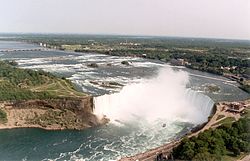- Knickpoint
-
A knickpoint is a term in geomorphology to describe a location in a river or channel where there is a sharp change in channel slope, such as a waterfall or lake, resulting from differential rates of erosion above and below the knickpoint. Differential rates of erosion can result from a change in the lithology of the river channel. Sharp changes in channel slope caused by faulting or in-channel construction are not considered knickpoints.
Knickpoints can also be caused by a change in base level. When a river is rejuvenated (that is, has a negative change in base level, the sea level falls), the long profile is lengthened as land rises from the sea. This increases the gradient of the long profile and causes the river to gain more erosive energy. The first knickpoint marks the position of the former base level but the knick point moves towards the source of the river as under rock erodes away to create a graded profile.
The river, having gained more potential energy due to gravity, will then proceed to work the knickpoints out of its system by either erosion (in the case of waterfalls) or deposition (in the case of lakes) in order for the river to reattain its smooth concave graded profile.
As is observed for many major waterfalls, knickpoints migrate upstream due to bedrock erosion.[1]
References
River morphology Large-scale features Alluvial rivers Meander • Meander cutoff • Point bar • Cut bank • Riffle • Stream pool • Braided river • Bar (river morphology) • Anabranch • River bifurcation • River channel migration • Oxbow lake • Floodplain • Riparian corridor • Avulsion (river) • Mouth bar • Thalweg • Channel patternBedrock river Canyon • Knickpoint • Plunge pool • Bedrock erosionBedforms Regional processes Mechanics Playfair's Law • Hack's law • Sediment transport • Water erosion • Deposition (geology) • Exner equationCategories:- Geomorphology stubs
- Geography terminology stubs
- Geomorphology
- Fluvial landforms
- Erosion landforms
Wikimedia Foundation. 2010.

